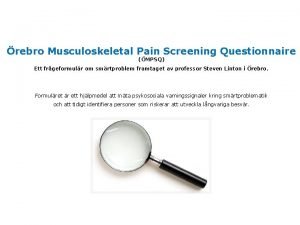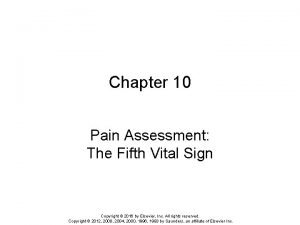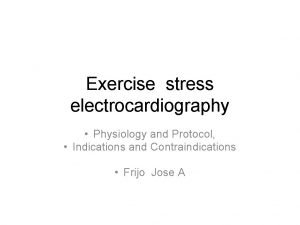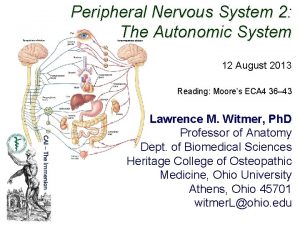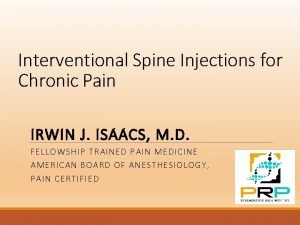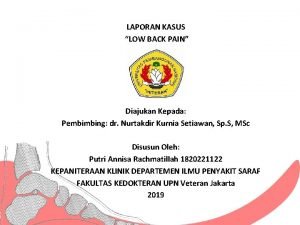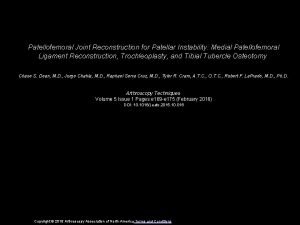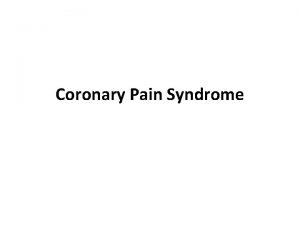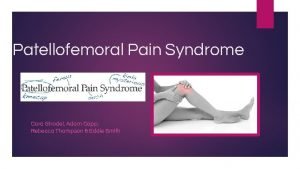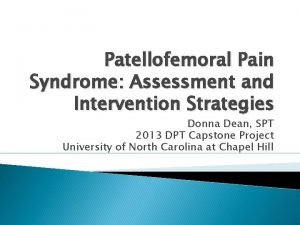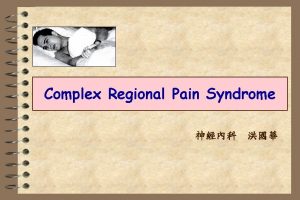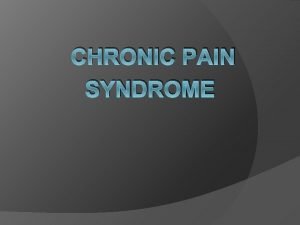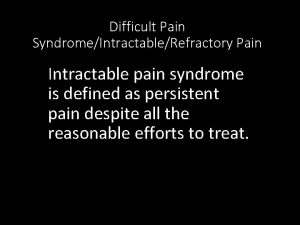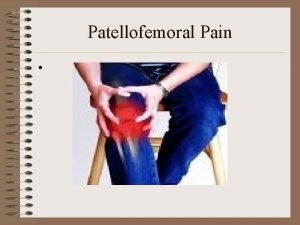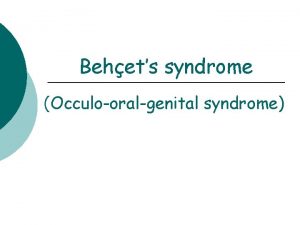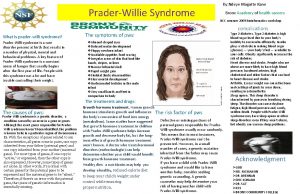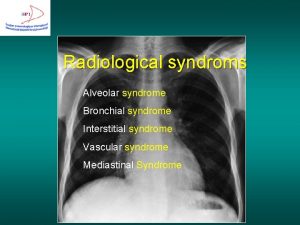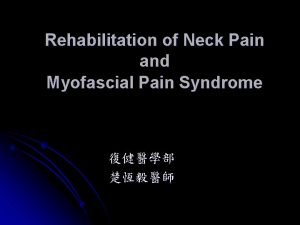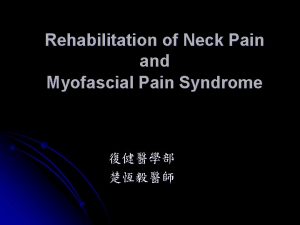Patellofemoral Pain Syndrome What is Patellofemoral Pain Syndrome



























- Slides: 27

Patellofemoral Pain Syndrome

What is Patellofemoral Pain Syndrome? • Patellofemoral Pain Syndrome is a spectrum of processes all characterized by retropatellar pain (behind the kneecap) or peripatellar pain (around the kneecap) arising from overuse and overload of the patellofemoral joint or from biomechanical or muscular changes in this joint.

Causes • Softening of the cartilage behind the patella(Chondromalacia) • Malalignment of patella • Tightening of tissue around patella • Overuse of patellofemoral joint – Occurs when the pressure between the patella and its contact points on the femur increase as the knee is bent. • Overload – Typically affects inactive patients who suddenly increase activity and stress to the joint. • Large Quadriceps Angle

Oth t n o C r e y r o t u rib s e s u a C

Biomechanical problems • Includes planus (pronation of the foot), pes cavus (supination of the foot), hyperpronation, tibial torsion, patellofemoral malalignment, femoral anteversion, and leg length discrepancies.

Muscular dysfunction problems • Includes weakness of the quadriceps, tight iliotibial bands, tight hamstrings, weakness or tightness of the hip muscles, or tight calf muscles.

Extrinsic Risk Factors • Includes poor technique, low quality sports, or a poorly designed or intensive training program.

Patient population most commonly affected by this condition? • Commonly occurs in adolescents and young adults, who regularly participate in high-impact sporting activities, such as running, basketball, and football. • Most commonly found in women

Diagnosis • The diagnosis of Patellofemoral Pain Syndrome is dependent on findings from the patient’s medical history and physical examination. • Diagnosis of Patellofemoral Pain Syndrome is divided into three general categories: – Presence of cartilage damage – Variable cartilage damage – Normal cartilage • Patellofemoral Pain Syndrome can be difficult to diagnose; however, x-rays can confirm or refine a suspected clinical diagnosis.

Clinical Presentation • Physical exam findings consistent with Patellofemoral Pain Syndrome include the following: – Pain is elicited by compression of the patella into the trochlear groove while the leg is extended – Gradual or acute onset of anterior knee pain – Pain behind or around the kneecap • Pain is exacerbated by running, squatting, jumping, prolonged sitting, or ascending/descending stairs – Catching sensation under the patella

Clinical Presentation • Patients with Patellofemoral Pain Syndrome classically present as either: – Retropatellar pain (pain behind the kneecap) – Peripatellar pain (pain around the kneecap)

Clinical Presentation • Signs: – – – – Soft tissue swelling Effusion Bruising Restricted joint movement Patellofemoral deformities Tenderness Reduced weight-bearing ability

Examination • A careful examination should be performed in both the prone and supine positions. • Systematic palpation should be used to reproduce the patient’s complaint and localize areas of tenderness. • A weight-bearing examination should also be done to assess obesity, atrophy, leg length, knee alignment, torsional deformities, and foot position. • The patient should also be examined for effusion, soft tissue swelling, bruising, and position, size, and shape of patella.

n o i t a n i m a x e l a c i Phys e h t e d u l c n will i : s t n e m e r u s a e m g n i w o l l o f

– Pronation – Patellar mobility – Patellar tracking

– Q-angle measurement – Medial and lateral translation – Quadriceps flexibility test

– Obers test – Hip extensor rotator muscle strength test – Hughston’s test: This test is used to rule out presence of Plica syndrome

Goals of treatment • • Reduce Inflammation Reduce pain Increase muscle strength and endurance Restore movement and function

t n e m t p o n o N a e r T e v i t era

Physical Therapy • Strengthening exercises – Focus on Quadriceps and Hip Abductors • Stretching exercises – Focus on Quadriceps, Hamstring, Iliotibial Band, and Gastrocnemius • Modalities – Icepacks and Ultrasound can be used to reduce pain and inflammation • Evaluation of footwear – Careful choice of footwear can minimize the risk of developing the condition and alleviating existing pain

Pharmacotherapy • NSAIDs – Used to reduce pain and inflammation

a r e Op e r T e v i t t n e atm

Arthroscopic Surgery • Used to examine the articular cartilage surrounding the patella and the patellofemoral groove and smooth off any rough surfaces.

Lateral Release Surgery • Used to re-correct the alignment of the patella by cutting the ligaments on the outside of the patella.

What is the outcome of treatment? • Refer to orthopedic surgeon if condition is severe enough to require surgery • Physical therapy – Improve lower extremity strength – Improve lower extremity flexibility • Prognosis: Good

Prevention • Avoid high impact activities that will exacerbate the condition – Walking up stairs – Squatting • Use appropriate athletic shoe with proper arch support

References • Ferri: Ferri’s Clinical Advisor 2011, 1 st Edition. Copyright © 2010 Mosby, An Imprint of Elsevier. • Lazoff, Marie. First Consult. Elseiver Inc. Copyright © 2011
 Dr sean keyes
Dr sean keyes Do you get period pains when pregnant
Do you get period pains when pregnant Symptoms before period
Symptoms before period Lewis mad pain and martian pain
Lewis mad pain and martian pain Total pain
Total pain Angulus venosus juguli
Angulus venosus juguli Nsaids examples
Nsaids examples Pico pain
Pico pain ömpsq
ömpsq Brief pain inventory
Brief pain inventory Chest pain in pediatrics
Chest pain in pediatrics Greek word for euthanasia
Greek word for euthanasia Angina pectoris nursing diagnosis
Angina pectoris nursing diagnosis Searing loss
Searing loss Mason liker
Mason liker Icd 10 codes gastroenterology
Icd 10 codes gastroenterology Total pain
Total pain True labour pain
True labour pain Sympathetic and parasympathetic nervous system difference
Sympathetic and parasympathetic nervous system difference Lumbar referral patterns
Lumbar referral patterns Long standing pain
Long standing pain Pain pathway spinal cord
Pain pathway spinal cord Laporan kasus ischialgia
Laporan kasus ischialgia Pancreatitis alcohol
Pancreatitis alcohol Pain receptors in brain
Pain receptors in brain Irving lichtenstein
Irving lichtenstein Nipple pain
Nipple pain Their pain your voice
Their pain your voice








